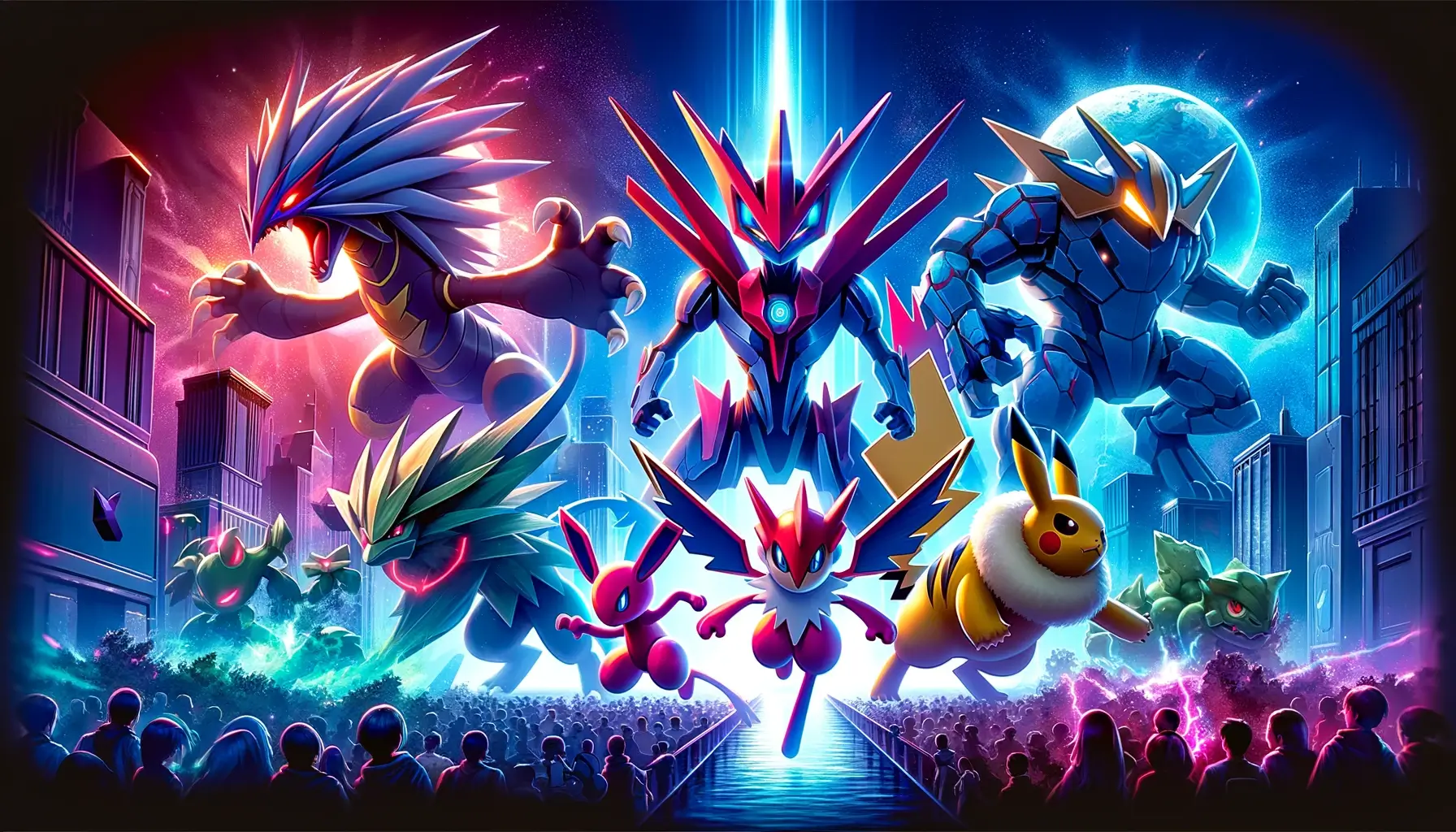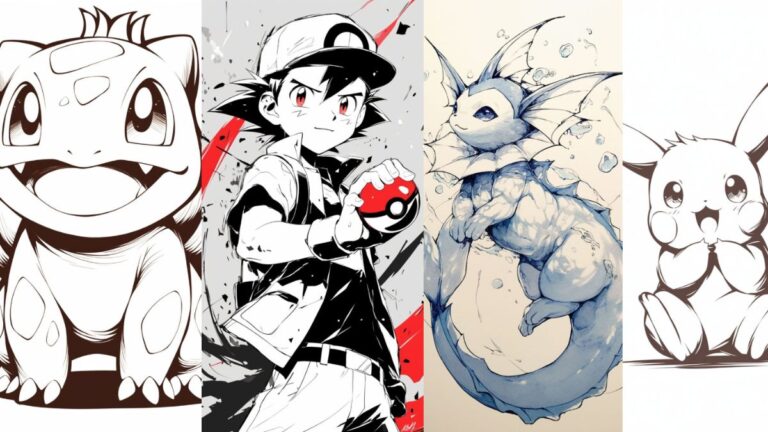Looking for the best Pokemon team Gen 6? Our detailed breakdown explores which Pokemon make the cut and how they can lead you to victory.
Key Takeaways – Best Pokemon Team Gen 6
- Building the best team involves understanding Gen 6’s unique features, like Mega Evolution.
- Team balance is essential, focusing on complementary roles and versatile movesets.
- Mastery of Gen 6 competitive play enhances the team-building and battling experience.
Essential Aspects of a Balanced Team – Best Pokemon Team Gen 6
Splitting text up into at most two sentences per paragraph.
Creating the ultimate Pokemon team in Generation 6 requires a deep understanding of how different elements interact to form an unbeatable squad. It’s not just about choosing strong Pokemon; it’s about crafting a team that works well together and can adapt to a variety of threats.
Team Synergy and Typing – Best Pokemon Team Gen 6
I’ve found that the heart of a potent Gen 6 team lies in team synergy and typing. I consider the balance between Steel, Dragon, and Fairy types, as these often dominate the OU tier.
For instance, Steel types like Aegislash can utilize Gyro Ball effectively due to their typically lower speed, turning a potential weakness into a strength. Additionally, Dragon types are formidable in attack, but adding a Fairy type to the mix can cover their weaknesses and offer a counter to other Dragon threats.
- Steel Types: Often carry Gyro Ball, provide strong defense
- Dragon Types: High attack power, vulnerable to Fairy types
- Fairy Types: Effective against Dragon and Dark types, add a layer of protection
Incorporating moves like Stealth Rock and Spikes can chip away at opposing Pokemon’s health and pressure them into making unfavorable switches. I always make sure to have at least one Pokemon in my lineup with the Recover or Leech Seed moves to maintain longevity and outlast the opponent.
Importance of Defensive Strategies – Best Pokemon Team Gen 6
When discussing defense, I prioritize a strategy that includes setting up hazards and employing reliable recovery moves.
A good defense can often be the best offense, so moves like Recover and hold items like Leftovers are crucial for durability. I also use Grass types for Leech Seed to sap the opponent’s health gradually while restoring my own.
- Recovery Moves: Essential for sustained defense (e.g., Recover)
- Hazards: Spikes, Stealth Rock weaken foes over time
- Hold Items: Leftovers for HP recovery every turn
A well-timed Haze can negate the opponent’s stat changes, effectively stopping sweepers in their tracks. Also, in sandy terrains, moves like Earthquake have an increased impact, and certain Pokemon with abilities like Sand Stream can turn the tide of battle by creating a sandstorm. In all my strategies, maintaining a solid defense, whether through passive damage with Spikes or robust Steel type defenders, is key to victory.
Selecting Your Core Pokemon – Best Pokemon Team Gen 6

Building the ideal team in Gen 6 involves identifying powerful synergies. I focus on two main aspects: an aggressive team that can apply pressure and a sturdy lineup that can withstand incoming attacks. Each core complements the other, creating a balanced and effective team.
Offensive Core Selection – Best Pokemon Team Gen 6
For my offensive core, I prioritize Pokemon that can switch in and out with ease and hit hard.
Talonflame is a prime choice for me with its access to Brave Bird and Flare Blitz, and the Gale Wings ability gives priority to its Flying-type moves. Pairing Talonflame with a Volt Switch user like Rotom-W allows me to keep momentum on my side, as the tactic encourages frequent and strategic switching.
- Talonflame: Fire/Flying type with Gale Wings.
- Rotom-W: A user of Volt Switch for maintaining momentum.
I also like to incorporate a Sand Rush user like Excadrill in teams that feature Tyranitar or Hippowdon, leveraging sandstorm conditions to double its Speed. Partnering Excadrill with a Grass type like Venusaur can help cover Weaknesses.
- Excadrill: Benefits from Sand Rush in a sandstorm.
- Tyranitar/Hippowdon: Sets sandstorms, boosting Excadrill’s Speed.
Defensive Core Essentials – Best Pokemon Team Gen 6
Building an impervious wall requires Pokemon that can heal, endure, and provide utility.
Chansey and Clefable, with Wish, are excellent for long-term sustenance, maintaining health across the team. I often equip them with a Leftovers item for passive recovery. Ferrothorn acts as a stellar physical barrier, with its Steel/Grass typing offering numerous resistances.
- Chansey: Utilizes Wish for team-wide healing.
- Clefable: Another Wish user, with versatility in movesets.
- Ferrothorn: A durable wall that can set hazards and resist key attack types.
Additionally, having a reliable Special Defense anchor like Goodra rounds out my defensive lineup. Goodra can absorb significant Special Attacks from formidable adversaries like Alakazam or Latios without breaking a sweat.
- Goodra: Tanky against Special Attacks, withstands hits from powerful Psychic types.
Specialized Roles and Movesets – Best Pokemon Team Gen 6
In Generation 6 competitive play, having a varied team with each Pokemon filling a specific role can be the difference between winning and losing. I’ll be discussing setup sweepers and wallbreakers, how utility and support moves can tip the scales, and the strategic use of choice items to enhance battle performance.
Setup Sweepers and Wallbreakers – Best Pokemon Team Gen 6
Setup sweepers are powerhouses that can use moves like Dragon Dance to dramatically boost their stats and sweep through enemy teams.
Charizard Y (Zard Y) with its Drought ability can increase the power of its Fire-type moves like Flamethrower, which becomes even more devastating after a few boosts. Dragon-type attackers often carry moves like Draco Meteor for high damage.
Wallbreakers like Aegislash and Mega-Lopunny (Lop), with their high Attack stats and Fighting-type moves, are excellent at breaking down defensive Pokemon to pave the way for sweepers.
- Dragon Dance Boosters: Charizard, Mega Charizard X (Zard X)
- Wallbreakers: Aegislash, Mega Lopunny
Utility and Support Options – Best Pokemon Team Gen 6
Support Pokemon add tremendous value with moves geared towards team survival and control.
Moves like Wish for healing, U-turn for momentum, Defog to clear entry hazards like Stealth Rock and Spikes, and Heal Bell to cure status conditions are pivotal in many strategies.
Rotom-W, with its Electric/Water typing and ability to use moves like Thunderbolt and Hydro Pump alongside utility moves like Recover and Defog, is an exceptional support option.
- Status and Healing: Recover (Rotom-W), Wish (Supportive Pokemon)
- Entry Hazards / Removal: Stealth Rock, Defog
Choice Item Strategies – Best Pokemon Team Gen 6
Choice Scarf and Choice Specs give Pokemon a one-track mind – lock into one move but get a huge stat boost in return.
Tactics such as Choice Scarf Excadrill outspeeding thanks to the item and turning the tide with moves like Earthquake or Iron Head show how pivotal item choice can be.
Meanwhile, offensive Pokemon may carry a Life Orb for a general power boost at the expense of some HP, which works wonders with moves like Psyshock, Ice Beam, or Brave Bird.
- Power Items: Life Orb (Offensive boosters), Choice Scarf (Speed-focused strategies)
- Common Attacks: Brave Bird, Psyshock, Ice Beam
Optimizing Pokemon Stats – Best Pokemon Team Gen 6
When crafting your best Pokemon team for Gen 6, I pay close attention to maximizing the potential of each Pokemon through EV spreads, natures, and abilities.
Understanding EV Spreads – Best Pokemon Team Gen 6
EVs (Effort Values) significantly influence how strong my Pokemon will be in their respective roles.
For example, to boost a Pokemon’s physical attacking prowess, I allocate 252 EVs into Atk to maximize its offensive capabilities.
When it comes to Nidoking, a popular choice in Gen 6, I often go for a sheer offensive route with 252 SpA (Special Attack EVs) to utilize its diverse movepool effectively.
Alternatively, if I’m using a Tangrowth, known for its physical bulk, I’ll focus on 252 HP EVs to enhance its survivability on the battlefield.
| Pokemon | EV Spread | Role |
|---|---|---|
| Nidoking | 252 SpA / 4 SpD / 252 Spe | Sp. Attacker |
| Tangrowth | 252 HP / 252 Def / 4 SpD | Bulky |
For Pokemon like Lapras, which can be bulky but also benefit from some speed, a mixed spread with EVs invested in HP and Speed could make a significant difference.
Choosing Natures and Abilities – Best Pokemon Team Gen 6
Selecting the right nature is critical. A nature like Jolly (+Speed, -SpA) is ideal for speedy Pokemon that rely on going first, such as those with the Sand Rush ability.
I’d opt for Adamant (+Atk, -SpA) for a more attack-focused build without the need for special attacks. For a Gastrodon, which is typically used in a stall strategy, a nature like Modest (+SpA, -Atk) helps it deal more damage while shrugging off hits with its naturally high HP and defenses.
Ability choice can also be a game-changer. Sand Rush, for example, doubles the Speed stat of a Pokemon in a sandstorm.
Imagine my Stoutland with Sand Rush, holding a 252 EV investment in Attack with an Adamant nature — it becomes an overwhelming force in a sandstorm setting.
Considering abilities and the presence of weather effects in Gen 6 is crucial. Some Pokemon, like Gastrodon with its Storm Drain ability, can absorb water-type moves and increase their own Sp. Atk, turning potential weaknesses into strengths.
Advanced Battling Techniques – Best Pokemon Team Gen 6
In competitive Pokemon battles, mastering advanced tactics can mean the difference between victory and defeat. These techniques are essential for gaining the upper hand against skilled opponents.
The Art of Switching – Best Pokemon Team Gen 6
Switching Pokemon effectively is a core skill in any trainer’s repertoire. My goal is to predict my opponent’s moves and switch in a Pokemon that can either resist the incoming attack or exploit the opponent’s weakness.
Moves like Volt Switch and U-Turn are pivotal, as they allow a Pokemon to deal damage and then switch out, granting what we call “switch initiative.” This lets me bring in a more favorable match-up without missing a beat.
Weather and Terrain Effects – Best Pokemon Team Gen 6
Weather and terrain are forces to be reckoned with. By initiating rain or a sandstorm with abilities like Drought or Sand Stream, or moves like Sunny Day or Sandstorm, I can give my team significant advantages.
Rain, for example, boosts Water-type moves and can be crucial for Pokemon with the Swift Swim ability, allowing them to outspeed most threats. Meanwhile, the sandstorm increases the Special Defense of Rock-type Pokémon and causes residual damage to all non-Rock, Ground, or Steel types each turn.
Entry Hazards and Their Removal – Best Pokemon Team Gen 6
Setting up entry hazards such as Stealth Rock, Spikes, and Toxic Spikes is a strategy I often employ to whittle down my opponent’s team. Each time they switch in a new Pokemon, it’s damaged by these hazards, tipping the scales in my favor.
However, I also need to be prepared for these myself, and moves like Defog and Rapid Spin are essential for removing hazards from my side of the field.
Defog wipes the slate clean but also clears any screens or hazards on the opponent’s field, while Rapid Spin removes hazards affecting me and has the added benefit of boosting the user’s Speed this generation.
Building Around Mega Evolution – Best Pokemon Team Gen 6
When constructing a team in Generation 6, Mega Evolution becomes a pivotal aspect of your strategy, often defining both the offensive and defensive capabilities of your team. Choosing the right Mega Pokemon can turn the tide in your favor, with various stones triggering the transformation. Let’s explore how Mega Evolution can shape your team dynamics and strategy.
Mega Pokemon Impact on Team Dynamics – Best Pokemon Team Gen 6
Mega Evolutions radically change the team’s dynamic by allowing a single Pokemon per battle to achieve an amplified form.
For example, when I use a Mega Stone with my Venusaur, its already formidable defensive capabilities are enhanced, giving me a much-needed sturdiness against common threats in the metagame. On the other hand, a Pokemon like Mega Medicham, which I personally find to be a powerhouse, brings an unbelievable offensive spike with its increased Attack stats.
To activate Mega Evolution, I ensure that my Pokemon is equipped with its specific Mega Stone and that I have a Mega Ring—a necessity for catalyzing the transformation during a battle.
A Pokemon like Mega Charizard can wield either Charizardite X or Y, drastically changing its role on the team based on the chosen Mega Stone. The X stone makes Charizard a physical attacker, whereas the Y stone heightens its special offensive abilities.
Mega Evolution Strategy and Synergy – Best Pokemon Team Gen 6
Implementing Mega Evolution into battle requires forethought and an understanding of synergy.
If I choose Mega Gardevoir, I focus my strategy around its strong special attack and team support capabilities. Meanwhile, a pick like Mega Lopunny, or Lop for short, grants my team high-speed and aggressive physical hitting power, perfect for a more direct offensive approach.
The key is to balance the team around the Mega Evolution. I ensure that my team can cover the weaknesses of my Mega Evolution choice.
For example, if I go with a high-offense Mega like Mega Diancie, I pair it with defensive stalwarts such as Aegislash to absorb hits and maintain pressure. Similarly, a choice like Mega Altaria requires team members that can capitalize on its ability to set up Dragon Dances and sweep through teams.
Balancing type coverage, stat distribution, and choosing between an offensive or defensive Mega Evolution approach is a constant juggling act. I make sure my selections enhance each other, making the Mega Evolution the centerpiece of my team’s strategy.
The Meta: Understanding Gen 6 Competitive Play – Best Pokemon Team Gen 6
When I discuss Gen 6 competitive play, I’m diving into a diverse ecosystem of Pokemon and strategies. It’s like a chess game; every move sets the stage for the next. Key elements like tier lists, ladder rankings, and tournament play define the battlefield.
Common Archetypes and Their Counters – Best Pokemon Team Gen 6
Stall: Stall teams focus on defensive endurance. These tanks can withstand heavy hits while employing status effects. However, they often struggle against Rain and Sand teams, which harness weather to boost their attacks or defenses. To counter Stall, I’d typically bring in a team with ample offensive pressure.
- Rain: Brings swift and hard-hitting Water-type moves. Countered by Pokemon that can absorb water attacks or change the weather.
- Sand: Buffs Rock, Ground, and Steel types. Beat it by weather disruption or employing Pokemon that capitalize on Sand’s weaknesses.
- Meta: Each strategy molds the overall competitive environment, which I must understand to predict and counter opponents effectively.
The counters to these archetypes are often found through match-ups that exploit their weaknesses. Sand teams, for example, decrease in potency when I switch in my weather changers, which nullifies their special defense boost from the sandstorm.
Adaptability and Counter-Teaming – Best Pokemon Team Gen 6
Over time, I’ve learned that being adaptable is crucial. The ability to modify my team in response to the shifting OU (OverUsed) tier meta can make the difference between victory and defeat.
Adaptability in this context refers to evolving strategies and team compositions based on frequent match-up experiences. This is evident on the ladder, where continuous play against a variety of teams sharpens my skills.
For counter-teaming, I prioritize knowledge about common team patterns. If hyper offense teams are trending, with their all-out aggressive approach to secure swift KOs, I adjust my team to be more defensive or speed-oriented to outpace them. Similarly, if a certain Pokemon becomes a linchpin in many fights on Victory Road, I’ll tailor my roster to face or neutralize that threat.
In essence, each battle is a learning experience. I keep notes on which strategies lead to a win or loss and tweak my approach accordingly. By staying informed and flexible, I navigate the Gen 6 competitive scene with confidence.
Pokemon and Move Selection – Best Pokemon Team Gen 6
When I assemble a team for Gen 6, it’s crucial to ensure that both the choice of Pokemon and their movesets are well-rounded. This balance increases the chances of adapting to various in-game scenarios.
Picking Versatile and Reliable Pokemon – Best Pokemon Team Gen 6
My priority is to pick Pokemon that can perform multiple roles and have good typing for STAB (Same-type attack bonus) moves. For example, Scizor offers great offensive and defensive capabilities, especially when equipped with moves that capitalize on its Bug and Steel typing.
Similarly, Keldeo and Heatran serve as potent special attackers. Keldeo’s Water/Fighting typing paired with moves like Hydro Pump gives it considerable coverage. Heatran, with its Fire/Steel typing, can take advantage of moves like Earthquake for hitting opponents hard, playing a strategic role in covering weaknesses within my team.
Choosing Moves That Offer Coverage – Best Pokemon Team Gen 6
I always ensure that my Pokemon have moves that offer a wide coverage of types to handle a variety of threats.
Rotom-W is an excellent example with its Electric/Water typing, allowing it to learn Thunderbolt, which is greatly beneficial against Flying and Water-types.
I often equip Latios with Draco Meteor for a powerful Dragon-type STAB move. Additionally, adding Ice Beam provides coverage against Dragon, Ground, Grass, and Flying-types.
For Excadrill, moves like Earthquake are nearly essential for STAB, and Rock Slide can be strategically important to flinch opponents while dealing with Flying-types.
Priority moves, like Lopunny’s Quick Attack, can also be clutch to outspeed and finish off weakened opponents, while Landorus can effectively use Knock Off to disrupt opponents’ strategies by removing their items.
In building a solid team, I also consider utility moves. Dragon Tail on a tanky Pokemon can force switches, disrupting the enemy setup, while status moves like Thunder Wave or Will-O-Wisp can cripple faster threats. The key is to create synergy among my Pokemon, so they cover each other’s weaknesses and create opportunities to pivot or sweep.
My Favorite Best Pokemon Teams Gen 6 – Best Pokemon Team Gen 6
In Gen 5, team-building really mattered to me, each choice reflecting a deep strategy and personal preference.
Each team setup aims to cover different strengths and strategies, allowing for adaptability based on the battle scenario and opponent’s team composition.
Team No 1 – Balanced Power
- Greninja – With its Hidden Ability, Protean, Greninja can change its type based on the move it uses, making it unpredictable and able to exploit enemy weaknesses.
- Talonflame – Known for its Speed and its Gale Wings ability, which gives priority to Flying-type moves when at full health, making it a formidable sweeper.
- Aegislash – Offers unique versatility with its Stance Change ability, shifting between offensive and defensive forms, providing both high attack and defense capabilities.
- Tyrantrum – A strong Rock/Dragon type with solid defenses and powerful attacking moves like Head Smash and Dragon Claw.
- Sylveon – A Fairy-type that serves as an excellent special defender and can use moves like Moonblast to handle Dragon-types effortlessly.
- Garchomp – Provides ground and dragon-type coverage and can be a major offensive threat with moves like Earthquake and Dragon Rush.
This team balances speed, attack power, and defensive capabilities, allowing for flexibility in battle tactics against a wide variety of opponents.
Team No 2 – Defense Strategy
- Goodra – Acts as a tank with its high Special Defense and ability to learn a variety of move types for coverage.
- Florges – Excellent special defense and Fairy typing make it a key player for countering Dragon, Dark, and Fighting-types.
- Chesnaught – With its Grass/Fighting typing and moves like Spiky Shield and Leech Seed, it can be a great physical defender and stall opponent.
- Mega Aggron – As a Mega Evolution, Aggron gains a significant boost in its Defense and becomes pure Steel-type, reducing its weaknesses.
- Dragalge – Offers Poison/Dragon typing, useful for spreading Toxic Spikes and countering Fairy-types with Sludge Bomb.
- Umbreon – Known for its stalling capabilities, with access to moves like Wish, Protect, and Foul Play to outlast opponents.
This team focuses on high defense and stalling tactics, making it difficult for opponents to break through while setting up favorable conditions.
Team No 3 – High Special Attack
- Volcarona – Though technically from Gen 5, it’s frequently used in Gen 6 battles for its devastating Quiver Dance boosts followed by powerful Fire and Bug-type moves.
- Alakazam – With its incredible Speed and Special Attack, Alakazam can use Psychic moves to hit hard and fast.
- Mega Gardevoir – Its Fairy typing and high Special Attack make it lethal against many types, especially with its Pixilate ability turning Normal-type moves into Fairy-type.
- Noivern – Fast and equipped with Boomburst, providing excellent Flying and Dragon-type coverage.
- Heliolisk – Can fulfill various roles with its diverse move pool, including Electric and Normal-type moves.
- Delphox – Fire/Psychic typing allows it to cover significant threats with moves like Mystical Fire and Psychic.
This team leverages high-speed and high special attack stats to outpace and overpower opponents before they can mount a defense.
Frequently Asked Questions – Best Pokemon Team Gen 6
In my experience as a Pokemon enthusiast, the key to success in Generation 6 lies in understanding the strategies, essential Pokemon, team compositions, balance, and the use of Legendaries in competitive play.
What are some top strategies for building a competitive team in Generation 6 of Pokemon?
I’ve found that incorporating a mix of offensive pressure and defensive resilience is crucial.
A common strategy involves setting up entry hazards to wear down the opposition, paired with powerful sweepers that can take advantage of weakened foes.
Which non-legendary Pokemon are considered essential for a strong Gen 6 team?
Pokemon such as Greninja and Talonflame are highly valued.
Their versatility and powerful abilities like Protean for Greninja and Gale Wings for Talonflame make them essentials for a strong Gen 6 team.
What are common Pokemon team compositions used in Gen 6 OU (Overused) tier?
Team compositions often include cores such as Fairy-Dragon-Steel, providing offensive and defensive coverage.
Teams usually have a mix of sweepers like Mega Mawile and support Pokemon like Heatran to maintain momentum.
How can I create a balanced team for Pokemon Showdown’s Gen 6 format?
To create a balanced team, I ensure there’s synergy between my Pokemon’s moves and abilities.
It’s important to cover a wide range of types and roles, like having both special and physical attackers as well as reliable wall Pokemon to absorb hits.
What factors should I consider when selecting the best Pokemon for my Gen 6 team?
When selecting Pokemon for my Gen 6 team, I consider type coverage, stats distribution, and movepool diversity.
Also, I pay attention to potential threats in the current metagame and ensure I have counters or checks for those specific opponents.
How do I effectively use Gen 6 Legendary Pokemon on a competitive team?
Using Gen 6 Legendaries effectively requires an understanding of their unique strengths.
For example, I use weather-setters like Primal Groudon to shape the battlefield to my advantage.
This ensures my team can capitalize on the conditions they create.





